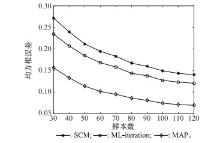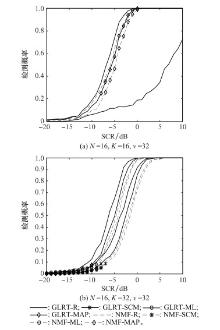| 1 |
KELLY E J . An adaptive detection algorithm[J]. IEEE Trans.on Aerospace and Electronic Systems, 1986, 22 (1): 115- 127.
|
| 2 |
CARRETERO-MOYA J , GISMERO-MENOYO J , BLANCO-DEL-CAMPO Á , et al. Statistical analysis of a high-resolution sea-clutter database[J]. IEEE Trans.on Geoscience and Remote Sensing, 2010, 48 (4): 2024- 2037.
doi: 10.1109/TGRS.2009.2033193
|
| 3 |
BILLINGSLEY J B , FARINA A , GINI F , et al. Statistical analyses of measured radar ground clutter data[J]. IEEE Trans.on Aerospace and Electronic Systems, 1999, 35 (2): 579- 593.
doi: 10.1109/7.766939
|
| 4 |
任双娇, 刘永祥, 黎湘, 等. 广义K分布杂波模型参数估计[J]. 电子学报, 2006, 34 (12): 2278- 2281.
doi: 10.3321/j.issn:0372-2112.2006.12.033
|
|
REN S J , LIU Y X , LI X , et al. Parameters estimation for generalized K-distributed clutter model[J]. Acta Electronica Sinica, 2006, 34 (12): 2278- 2281.
doi: 10.3321/j.issn:0372-2112.2006.12.033
|
| 5 |
CONTE E , DE M A , GALDI C . Statistical analysis of real clutter at different range resolutions[J]. IEEE Trans.on Aerospace and Electronic Systems, 2004, 40 (3): 903- 918.
doi: 10.1109/TAES.2004.1337463
|
| 6 |
姜斌, 黎湘, 王宏强, 等. 近海岸复合杂波建模及其统计特性研究[J]. 系统工程与电子技术, 2006, 28 (2): 221- 223, 309.
doi: 10.3321/j.issn:1001-506X.2006.02.017
|
|
JIANG B , LI X , WANG H Q , et al. Studies on the modeling and statistic characteristic of compound clutter under the coastal environment[J]. Systems Engineering and Electronics, 2006, 28 (2): 221- 223, 309.
doi: 10.3321/j.issn:1001-506X.2006.02.017
|
| 7 |
CONTE E , MAIO A D . Mitigation techniques for non-Gaussian sea clutter[J]. IEEE Journal of Oceanic Engineering, 2004, 29 (2): 284- 302.
doi: 10.1109/JOE.2004.826901
|
| 8 |
BALLERI A , NEHORAI A , WANG J . Maximum likelihood estimation for compound-Gaussian clutter with inverse Gamma texture[J]. IEEE Trans.on Aerospace and Electronic Systems, 2007, 43 (2): 775- 779.
doi: 10.1109/TAES.2007.4285370
|
| 9 |
SHANG X , SONG H . Radar detection based on compound-Gaussian model with inverse Gamma texture[J]. IET Radar, Sonar & Navigation, 2011, 5 (3): 315- 321.
|
| 10 |
CONTE E , LOPS M , RICCI G . Adaptive matched filter detection in spherically invariant noise[J]. IEEE Signal Processing Letters, 1996, 3 (8): 248- 250.
doi: 10.1109/97.511809
|
| 11 |
GINI F , GRECO M . Covariance matrix estimation for CFAR detection in correlated heavy tailed clutter[J]. Signal Processing, 2002, 82 (12): 1847- 1859.
doi: 10.1016/S0165-1684(02)00315-8
|
| 12 |
CHITOUR Y , PASCAL F . Exact maximum likelihood estimates for SIRV covariance matrix: existence and algorithm analysis[J]. IEEE Trans.on Signal Processing, 2008, 56 (10): 4563- 4573.
doi: 10.1109/TSP.2008.927464
|
| 13 |
GINI F , RANGASWAMY M . Knowledge based radar detection, tracking and classification[M]. New Jersey: John Wiley and Sons, 2008.
|
| 14 |
GAO Y , LI H , HIMED B . Knowledge-aided range-spread target detection for distributed MIMO radar in nonhomogeneous environments[J]. IEEE Trans.on Signal Processing, 2017, 65 (3): 617- 627.
doi: 10.1109/TSP.2016.2625266
|
| 15 |
OLLILA E , TYLER D E , KOIVUNEN V , et al. Compound-Gaussian clutter modeling with an inverse Gaussian texture distribution[J]. IEEE Signal Processing Letters, 2012, 19 (12): 876- 879.
doi: 10.1109/LSP.2012.2221698
|
| 16 |
SHUI P L , SHI L X , YU H , et al. Iterative maximum likelihood and outlier-robust bipercentile estimation of parameters of compound-Gaussian clutter with inverse Gaussian texture[J]. IEEE Signal Processing Letters, 2016, 23 (11): 1572- 1576.
doi: 10.1109/LSP.2016.2605129
|
| 17 |
张洋忠, 张玉, 胡进, 等. 复合高斯杂波中知识辅助的自适应检测算法[J]. 现代雷达, 2016, 38 (7): 40- 43.
|
|
ZHANG Y Z , ZHANG Y , HU J , et al. Knowledge-aided adaptive detection algorithm in compound-Gaussian clutter[J]. Modern Radar, 2016, 38 (7): 40- 43.
|
| 18 |
时艳玲, 刘浩, 刘子鹏, 等. 基于GLRT的逆高斯纹理海杂波背景下目标检测器[J]. 信号处理, 2020, 36 (12): 2067- 2073.
|
|
SHI Y L , LIU H , LIU Z P , et al. The GLRT to detect target in sea clutter with inverse Gaussian texture[J]. Journal of Signal Processing, 2020, 36 (12): 2067- 2073.
|
| 19 |
XU S W , XUE J , SHUI P L . Adaptive detection of range-spread targets in compound Gaussian clutter with the square root of inverse Gaussian texture[J]. Digital Signal Processing, 2016, 56, 132- 139.
doi: 10.1016/j.dsp.2016.06.009
|
| 20 |
施赛楠, 水鹏朗, 杨春娇, 等. 基于逆高斯纹理空间相关性的雷达目标检测[J]. 系统工程与电子技术, 2017, 39 (10): 2215- 2220.
|
|
SHI S N , SHUI P L , YANG C J , et al. Radar target detection based on spatial correlation of inverse Gaussian texture[J]. Systems Engineering and Electronics, 2017, 39 (10): 2215- 2220.
|
| 21 |
GRADSHTEYN I S , RYZHIK I M . Table of integrals, series, and products[J]. Mathematics of Computation, 2007, 20 (96): 1157- 1160.
|



